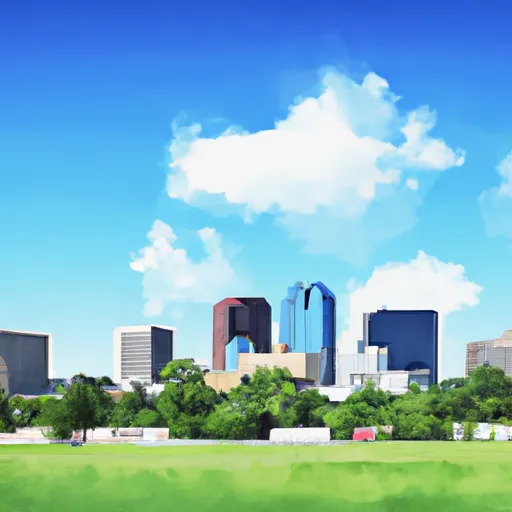-
 Snoflo Premium
Snoflo Premium
Get unlimited access to all our content
With no Ad interruptions! - Start Your Free Trial Login with existing account
Shavano-Park
Eden Index
Climate
8.0
•
Recreation
4.9
•
Community
4.1
•
Safeguard
5.9/10

Shavano Park is a small, affluent city located in Bexar County, Texas. The city enjoys a warm and humid subtropical climate, with hot summers and mild winters. Summers are typically hot and dry, with average temperatures ranging from the mid-90s°F (35°C) to low 100s°F (38°C). Winters are mild, with average temperatures in the 60s°F (15-20°C), occasionally dropping down to the 30s°F (0-5°C).
The hydrology constituents in Shavano Park are primarily influenced by the Balcones Fault Zone, resulting in diverse geology and underground water sources. The region receives an average of 34 inches (86 cm) of rainfall per year, with occasional heavy downpours during the summer months. The rainfall contributes to the recharge of aquifers, supporting the city's water supply.
Shavano Park offers various outdoor recreation opportunities for its residents and visitors. The city is home to several parks and green spaces, providing opportunities for walking, jogging, and picnicking. There are also nearby nature reserves and trails, such as the Eisenhower Park and the Salado Creek Greenway, where visitors can enjoy hiking, biking, and birdwatching. The city's favorable climate allows for year-round outdoor activities, making it an attractive destination for nature enthusiasts.
What is the Eden Index?
The Snoflo Eden Index serves as a comprehensive rating system for regions, evaluating their desirability through a holistic assessment of climate health, outdoor recreation opportunities, and natural disaster risk, acknowledging the profound impact of these factors on livability and well-being.
Climate Health Indicator (CHI): 8.0
Shavano-Park receives approximately
820mm of rain per year,
with humidity levels near 83%
and air temperatures averaging around
21°C.
Shavano-Park has a plant hardyness factor of
8, meaning
plants and agriculture in this region tend to thrive here all year round.
By considering the ideal temperature range, reliable water supplies, clean air, and stable seasonal rain or snowpacks, the Climate Health Indicator (CHI) underscores the significance of a healthy climate as the foundation for quality living.
A healthy climate is paramount for ensuring a high quality of life and livability in a region, fostering both physical well-being and environmental harmony. This can be characterized by ideal temperatures, reliable access to water supplies, clean air, and consistent seasonal rain or snowpacks.
Weather Forecast
Streamflow Conditions
San Antonio
Area Rivers
San Antonio
Snowpack Depths
San Antonio
Reservoir Storage Capacity
San Antonio
Groundwater Levels
Recreational Opportunity Index (ROI): 4.9
The Recreational Opportunity Index (ROI) recognizes the value of outdoor recreational options, such as parks, hiking trails, camping sites, and fishing spots, while acknowledging that climate plays a pivotal role in ensuring the comfort and consistency of these experiences.
Access to outdoor recreational opportunities, encompassing activities such as parks, hiking, camping, and fishing, is crucial for overall well-being, and the climate plays a pivotal role in enabling and enhancing these experiences, ensuring that individuals can engage in nature-based activities comfortably and consistently.
Camping Areas
| Campground | Campsites | Reservations | Toilets | Showers | Elevation |
|---|---|---|---|---|---|
| Black Rock Park | 36 | 1,034 ft | |||
| Escondido Ranch Military - Kingsville NAS | None | 265 ft | |||
| Badu Park | 15 | 1,011 ft | |||
| Cedar Point Rec Area | None | 1,016 ft | |||
| Calliham - Choke Canyon State Park | 40 | 243 ft | |||
| Lackland AFB Military | None | 734 ft | |||
| Canyon of the Eagles Nature Park | 33 | 1,103 ft | |||
| Blanco State Park | 35 | 1,319 ft | |||
| Inks Lake State Park | 197 | 920 ft | |||
| Braunig Lake Park | None | 514 ft |
Nearby Ski Areas
Catastrophe Safeguard Index (CSI):
The Catastrophe Safeguard Index (CSI) recognizes that natural disaster risk, encompassing floods, fires, hurricanes, and tornadoes, can drastically affect safety and the overall appeal of an area.
The level of natural disaster risk in a region significantly affects safety and the overall livability, with climate change amplifying these risks by potentially increasing the frequency and intensity of events like floods, fires, hurricanes, and tornadoes, thereby posing substantial challenges to community resilience and well-being.
Community Resilience Indicator (CRI): 4.1
The Community Resilience Indicator (CRI) recognizes that education, healthcare, and socioeconomics are crucial to the well-being of a region. The CRI acknowledges the profound impact of these elements on residents' overall quality of life. By evaluating educational resources, healthcare accessibility, and economic inclusivity, the index captures the essential aspects that contribute to a thriving community, fostering resident satisfaction, equity, and social cohesion.

